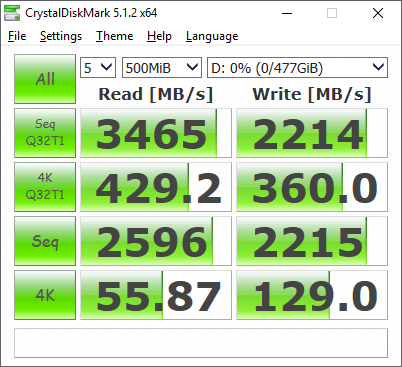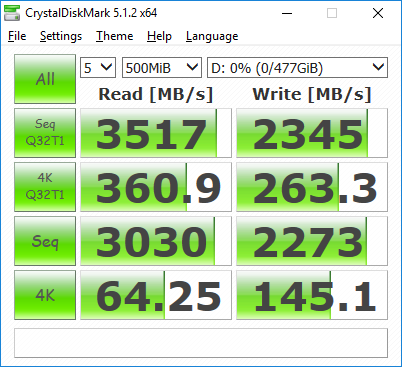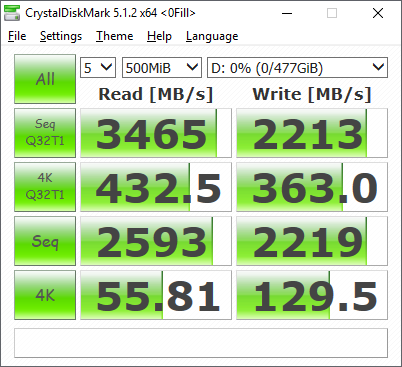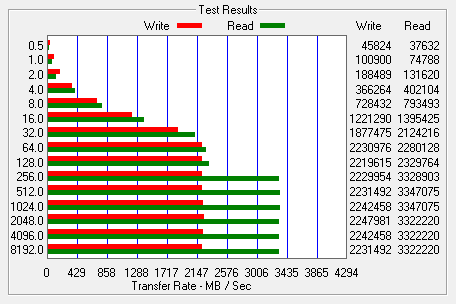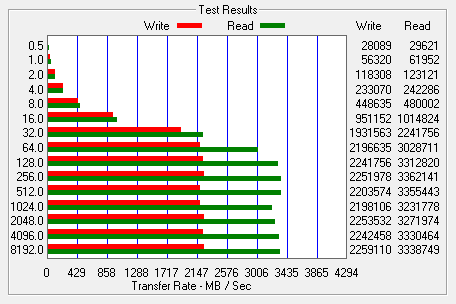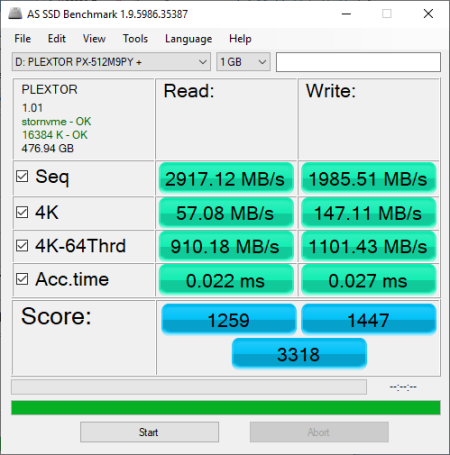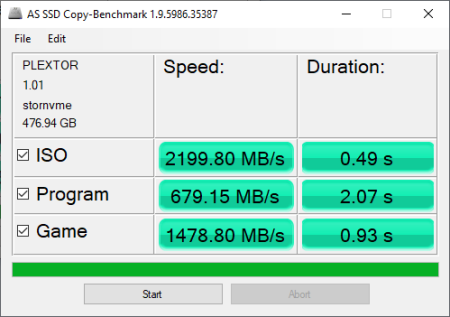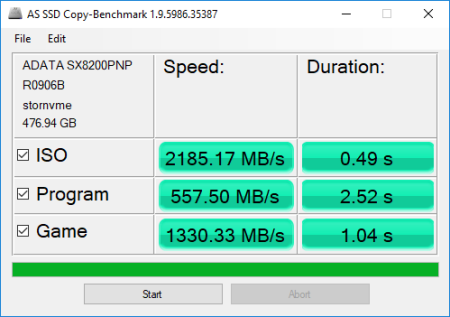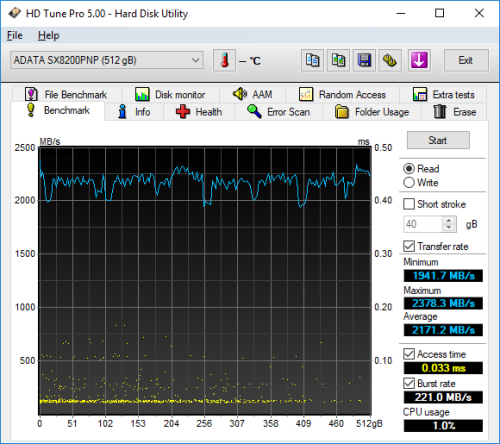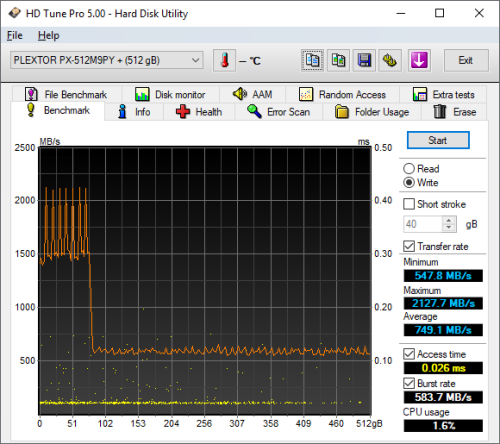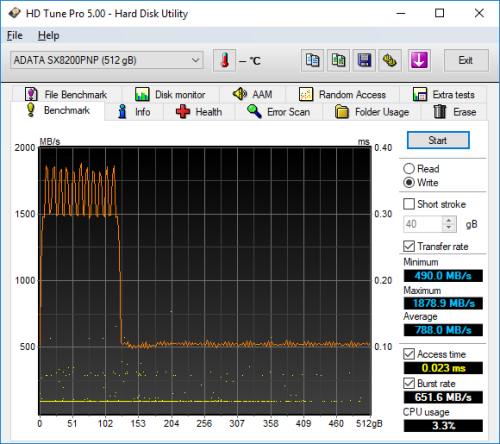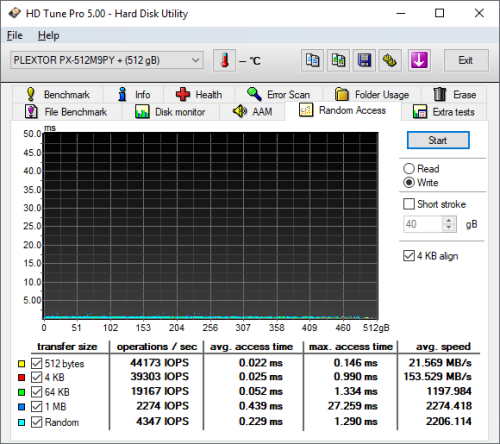

Model: Plextor M9PY Plus 512GB NVMe PCIe Solid State Drive
Manufacturer: Plextor
Provided By: Plextor LLC
As one of the biggest names in the storage industry, Plextor doesn't need much of an introduction. For nearly twenty years, they've produced some of the best optical drives the industry has seen. Known the world over for their quality, performance, and features, these drives have become favorites among consumers and professionals alike. Today, Plextor continues to lead the way by bringing cutting edge storage technologies to market. Along with an assortment of high-performance DVD and Blu-ray drives, the company offers a growing number of solid state drives.
At this year's Consumer Electronics Show (CES), Plextor showcased its latest PCIe SSD, the M9P Plus. Designed for PC gamers and prosumers with intensive application requirements, this M.2 form factor drive is powered by Marvell's 88SS1092 "Eldora Plus" controller and is available with up to 1TB of Toshiba's 96-layer BiCS4 3D NAND flash. The M9P Plus is also equipped with a PCIe Gen3 x4 NVMe 1.3 interface and features support for Plextor's new and improved PlexNitro II, TrueProtect II and SmartProtect technologies.
Like its predecessors, the M9P Plus is offered in a number of different capacities and configurations. The drive is available by itself in the M.2 2280 form factor (M9PGN Plus), with a small aluminum heatsink (M9PG Plus) and as an HHHL add-in card (M9PY Plus) that's equipped with an extra large heatsink and RGB LED lights. For this review, Plextor sent us the 512GB version of the of the add-in card, which is capable of delivering up to 3,400 MB/s sequential read and 2,200 MB/s sequential write speeds along with up to 340,000 random read and 320,000 random write IOPS.
| Plextor M9PY Plus 512GB NVMe PCIe Solid State Drive | |||||||||||||||||||||||||||||||||||
General Specifications
Performance
Environment and Reliability
Dimensions and Weight
Other Features
|
Needless to say, this is only a taste of what the M9P Plus has to offer. To give you an idea of what to expect, we'll take a closer look at Plextor's new PCIe SSD and then see how well it performs. Does the M9P Plus have what it takes? Can it deliver the performance and features that we've come to expect from Plextor? Keep reading as we find out.
The HHHL (Half-Height/Half-Length) version of the M9PY Plus comes packaged in an attractive black and rainbow colored box. The front advertises key features like the drive's 512GB capacity, support for NVMe, RGB LED lights and 5 year warranty. The back of the box provides a bit more information regarding the M9PY Plus' features, specifications and box contents.


Inside the box, you'll find the M9PY Plus, a low profile, half height bracket for use in servers and small form factor PCs, and a fold out guide containing warranty information as well as some brief installation instructions.

Physical Features:
Like Plextor's previous HHHL SSDs, the M9PY Plus is very well constructed. The top of the PCIe add-in card is covered entirely by a massive aluminum heatsink which has a nice black finish. The M9PY Plus also has a bright red bubble with the Plextor logo on it.


Along the top of the M9PY Plus there is a strip of RGB LEDs that light up red when the drive is powered on and will slowly cycle between various colors while it is in standby mode. During a read or write process, the color change speeds up to create a rainbow effect. Unfortunately, there is currently no way to customize the lighting effects or turn the LEDs off.
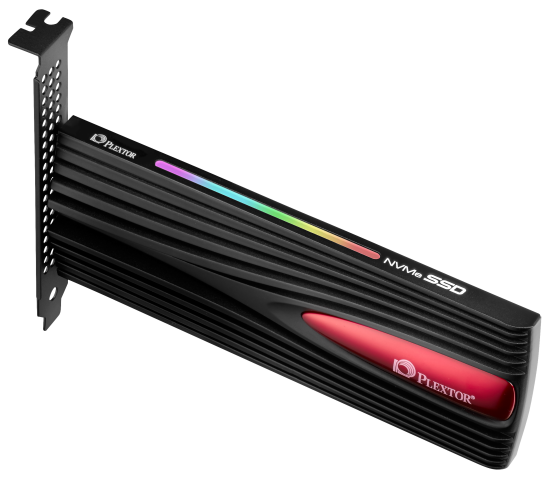
If you want to void your warranty, the heatsink can be removed by taking out a few of the screws on the back of the card. With it removed, you can see the large thermal pad that Plextor has sandwiched inbetween the drive and heatsink.
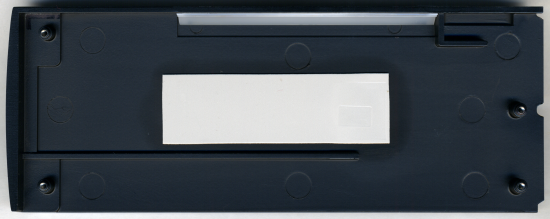
With the heatsink out of the way, you can see the strip of LEDs along the top as well as the SSD itself. The drive is inserted into an M.2 slot and is held in place using a screw.
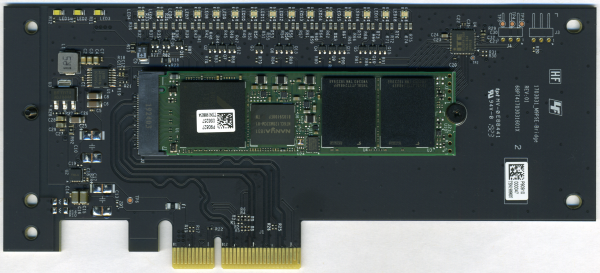
The M9PY Plus uses Marvell's 88SS1092 "Eldora Plus" controller. This 8 channel, PCIe Gen 3 x4 NVMe SSD controller is equipped with three ARM Cortex R5 cores and features support for 15/16nm MLC/TLC and 3D NAND. The 88SS1092 also integrates Marvell’s third generation low-density parity check (LDPC) technology for higher reliability and endurance.


For the 512GB version of the M9PY Plus, Plextor used Toshiba's 96-layer BiCS 4 3D NAND flash. Looking at the pictures above, you can see that there are two 256GB NAND flash packages on the top of the PCB. The drive also has a single NANYA 512MB LPDDR3 DRAM memory chip that is used for caching.
The test system used in this review is equipped with an Intel Core i7-6700K CPU, GIGABYTE GA-Z170X-UD3 motherboard, 32GB (16GB x 2) of Crucial Ballistix Sport LT DDR4 memory, Samsung 960 PRO 512GB SSD and a GIGABYTE GeForce GTX 1060 WINDFORCE OC 6G graphics card. For the operating system, I installed a fresh copy of Windows 10 Enterprise.
To test the performance of Plextor's M9PY Plus SSD, I ran a series of benchmarks using CrystalDiskMark, HD Tach RW, ATTO Disk Benchmark, AS SSD, HD Tune Pro, Anvil's Storage Utilities, Iometer and PCMark 8. For comparison, I've also included test results from the ADATA XPG SX6000 Pro, Western Digital WD Black SN750, Samsung 970 EVO Plus, ADATA XPG SX8200 Pro, Crucial P1, ADATA XPG SX8200, Western Digital WD Black NVMe, Samsung 970 EVO, Samsung 970 PRO, Plextor M9Pe, Plextor M8Se, Patriot Hellfire, ADATA XPG SX8000, Samsung 960 PRO, Toshiba OCZ RD400, Samsung 950 PRO, Samsung 860 QVO, Samsung 860 PRO, Crucial MX500, Plextor M8V, Samsung T5, Crucial BX300, ADATA Ultimate SU900, Plextor S3C, Toshiba OCZ VX500 and ADATA Ultimate SU800.
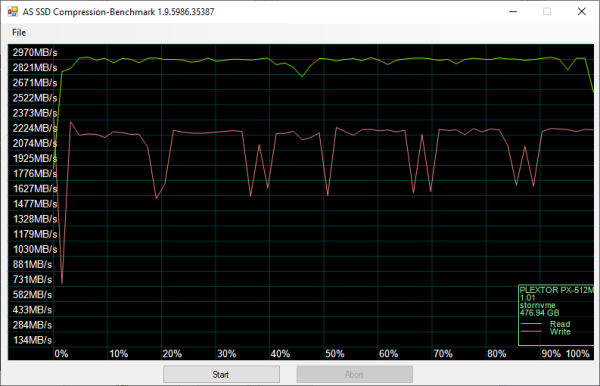
As I mentioned earlier, the M9PY Plus is based on Marvell's 88SS1092 controller chip. Looking at the screenshot above, you can see that it performs equally well with both incompressible (0%) and compressible (100%) data.
CrystalDiskMark 5.1.2:
First, I ran a few quick tests using CrystalDiskMark. This benchmark tool measures the performance of a storage device by testing its sequential read and write speeds as well as its random read and write speeds using blocks 512K and 4K in size.
According to Plextor, the 512GB version of the M9PY Plus is capable of reading at 3,400 MB/s and writing at 2,200 MB/s. Looking at the screenshot above, you can see that the drive had no problems reaching these speeds in CrystalDiskMark's sequential read and write tests.
The M9PY Plus performed equally well when using highly compressible 0x00 (0 Fill) data. This time around, the drive was able to read at 3,465 MB/s and write at 2,213 MB/s.
HD Tach RW 3.0.4.0:
Next, I used HD Tach to test the Plextor M9PY Plus' read, write and burst speeds as well as its seek times and CPU usage.

Looking at the screenshot above, you can see that the M9PY Plus had average read and write speeds of 1,402.0 MB/s and 663.7 MB/s, respectively, as well as a burst speed of 559.4 MB/s. The screenshot also shows that, like most other TLC-based SSDs, the M9PY Plus uses some sort of SLC caching. The drive starts writing at about 1,300 MB/s and then drops to about 650 MB/s when the write operation exceeds the size of the cache.
ATTO Disk Benchmark 2.46:
I also used ATTO Disk Benchmark to test the Plextor M9PY Plus' sequential read and write speeds. The tests are run using blocks ranging in size from 0.5KB to 8192KB and the total length set to 256MB.
When tested with ATTO, the Plextor M9PY Plus' read speeds topped out at about 3,347 MB/s and its write speeds at 2,247 MB/s.
AS SSD:
AS SSD is a benchmark designed specifically for solid state drives. The application contains five synthetic tests used to determine the sequential and random read and write performance of a drive.
AS SSD also includes a copy benchmark. This test copies an ISO (two large files), program (many small files) and game (small and large files), returning the speed and duration of each.
HD Tune Pro 5.00:
Next, I ran a series of tests using HD Tune Pro. This hard disk utility measures a drive's performance by testing its sequential read and write speeds as well as its access time, burst rate and CPU usage. For this review, I'm also going to use it to benchmark the Plextor M9PY Plus' random read and write speeds, random access times and the number of operations per second.
The M9PY Plus performed relatively well when benchmarked with HD Tune. The drive had average read and write speeds of 2540.3 MB/s and 749.1 MB/s, respectively, and a burst rate of about 618.4 MB/s when reading.
When writing 4KB blocks, the M9PY Plus reached 39,303 IOPS and had an average speed of 153.529 MB/s. The drive was even faster when reading, reaching 41,644 IOPS with an average speed of 162.672 MB/s.
Anvil's Storage Utilities:
Anvil's Storage Utilities is another benchmark designed with SSDs in mind. The standard storage benchmark measures a drive's performance by testing its transfer speeds, access times and IOPS.

Iometer:
Lastly, I ran a series of tests using Iometer. This tool can be configured to benchmark a number of things. In this case, I used it to measure the M9PY Plus' read and write speeds and the number of operations per second. The tests were run using random bytes and a queue depth of 3.
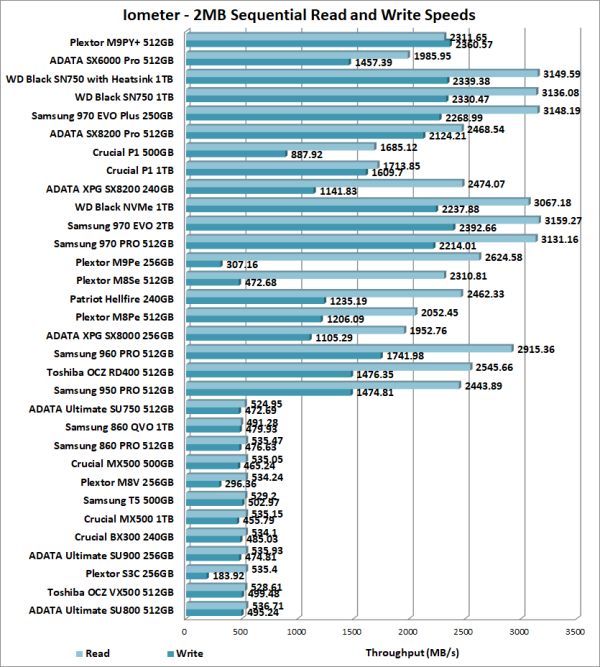
The M9PY Plus' performance was hit and miss when tested with Iometer. While the drive was able to write at a respectable 2360.57 MB/s, its sequential read speed averaged out at only 2311.65 MB/s.

The M9PY Plus also performed fairly well when doing random reads and writes. In our tests, the drive was able to read at 344.43 MB/s and write at 780.89 MB/s.

According to Plextor, the 512GB M9PY Plus is capable of up to 340,000 IOPS when reading and 320,000 IOPS when writing 4K blocks. In our tests, the drive reached 88,174 random read IOPS and 199,907 random write IOPS. As with most drives, the M9PY Plus performed better at higher queue depths. With four threads and the queue depth set to 32, it reached 380,236 random read IOPS and 304,389 random write IOPS.
PCMark 8 - Storage Test:
PCMark 8 is a complete benchmark for Windows. It includes five benchmark tests, each designed around a specific scenario. The storage benchmark measures drive performance using real-world traces recorded from Adobe Creative Suite, Microsoft Office and a selection of popular games.
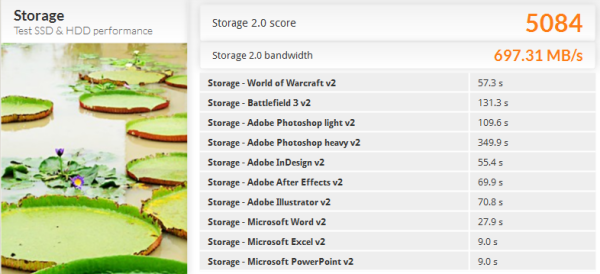
PCMark 8 also includes a consistency test which measures the performance consistency and degradation tendency of a storage system. The test reports the performance level at the start, the degraded steady-state and the recovered state as well as the number of iterations required to reach the degraded state and the recovered state. For this test, we are focusing on the Adobe Photoshop (Heavy) trace and will look at both the bandwidth and latency of the drive

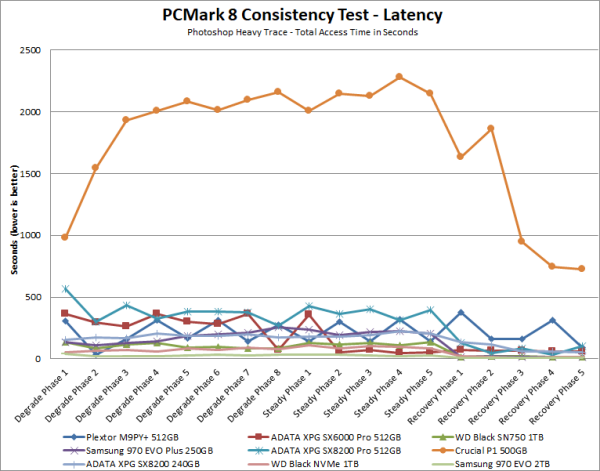
The M9PY Plus didn't do as well as some of the other drives in this test. Its bandwidth dropped below 125 MB/s during the degradation and steady state phases, pushing its latency above the 300ms mark. The M9PY Plus' performance increased somewhat during the recovery phase. However, it lagged well behind the drives from Samsung and Western Digital, topping out at only 405 MB/s.
TRIM Performance:
While SSD's offer many benefits, there are some downsides to using flash memory. One of the biggest issues people run into is performance degradation. Over time, an SSD will run out of fresh blocks and will have to write over data the file system has marked as deleted. This procedure is very complicated and can slow an SSD's write speeds considerably.
To fix this problem, most manufacturers have added TRIM support to their SSDs. The TRIM command allows an operating system, such as Windows 7, to tell an SSD which data blocks are no longer in use. Using this information, the drive pro-actively erases these blocks and adds them to the free block pool.

To test the M9PY Plus' TRIM and garbage collection functions, I first put the drive in a "dirty" state. I used Iometer to fill 80% of the drive and then ran a random write test for 30 minutes. Looking at the screenshot below, you can see that the M9PY Plus' average read and write speeds dropped to 2665.79 MB/s and 245.59 MB/s, respectively.

Plextor M9PY Plus - Dirty
To see how well the M9PY Plus could recover, I let the computer sit for about 45 minutes and then reran the test. The drive's average read speed climbed up to 2675.39 MB/s. However, its write speed lagged behind, averaging out at only 618.34 MB/s.

Plextor M9PY Plus - After TRIM
Lastly, I used Parted Magic to perform a secure erase on the M9PY Plus. With the drive wiped clean, it had average read and write speeds of 2928.61 MB/s and 1999.03 MB/s, respectively.
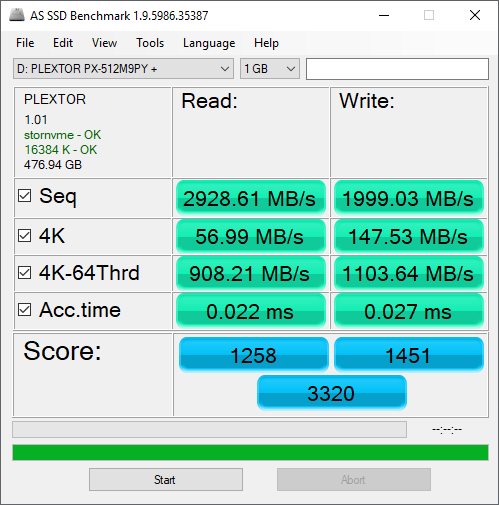
Plextor M9PY Plus - Secure Erased
Final Thoughts:
At first glance, the M9P Plus series may seem like nothing more than the M9Pe with a fresh coat of paint. However, Plextor's engineers have made a number of changes under the hood. Along with new and improved technologies like PlexNitro II, TrueProtect II and SmartProtect, the M9P Plus is powered by Marvell's 88SS1092 controller and is available with up to 1TB of Toshiba's 96-layer BiCS4 3D NAND flash. Combine this with a PCIe Gen3 x4 NVMe 1.3 interface and you have a reasonably priced drive capable of delivering more than six times the performance of your average SATA 6Gb/s SSD. In our sequential read and write tests, the 512GB version of the M9PY Plus was able to read at speeds as high as 3,465 MB/s and write at speeds in excess of 2,213 MB/s. The drive also did very well in our random write tests, producing nearly 200,000 IOPS at low queue depths.
According to Plextor, the M9P Plus will be available at retailers in early March in 256GB, 512GB and 1TB capacities. The suggested retail prices are expected to range from about $45 up to $145 with the 512GB HHHL version reviewed here going for about $97.

Highs:
- Available in 256GB, 512GB and 1TB capacities
- PCIe 3.0 x4 interface with NVMe protocol
- Marvell 88SS1092 controller
- Equipped with Toshiba 96-layer BiCS4 3D TLC NAND
- Good sequential read and write performance
- Supports Plextor's PlexNitro II, TrueProtect II and SmartProtect technologies
- M.2 2280 and HHHL PCIe form factors
- Large DRAM cache
- Reasonably priced
- 5 year warranty
Lows:
- Write speed drops when SLC cache is full
- Does not support hardware based encryption
- No way to customize or turn off RGB lights
